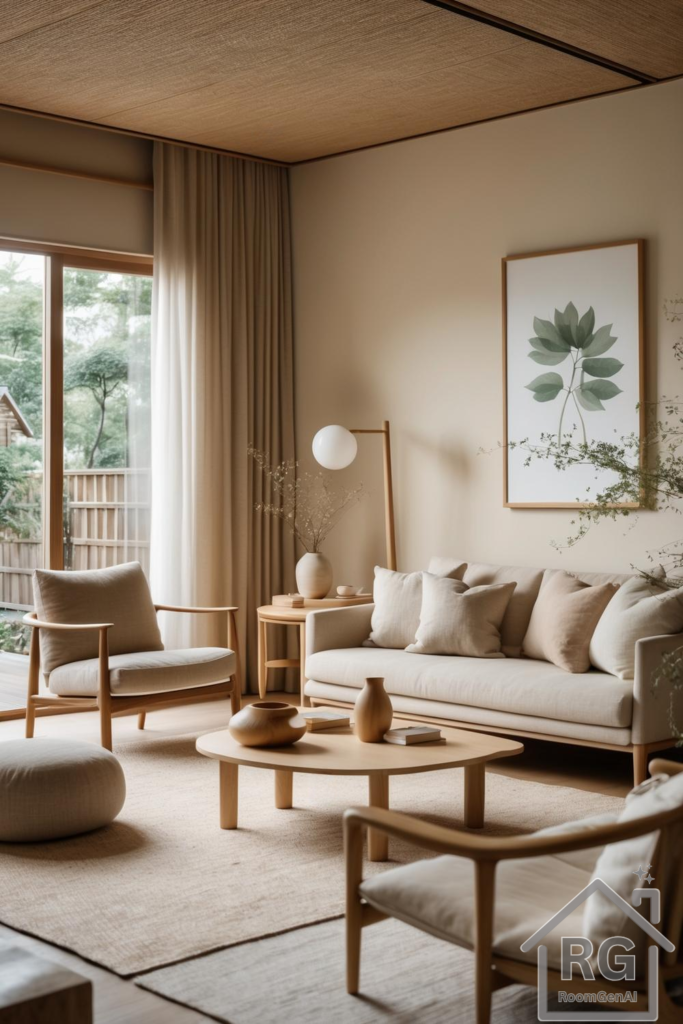
(Color Palette Disclaimer: The color palette referenced here is approximate and may vary based on screen settings and printing methods. Always test paint swatches and fabrics in your space before making final decisions.)
(Affiliate Disclosure: Some of the links in this post may be affiliate links, which means I may earn a small commission if you make a purchase through them—at no extra cost to you. Thank you for supporting my work and helping me continue to provide free content!)
Japandi style, a harmonious blend of Japanese and Scandinavian design, offers a serene and functional living space that feels both warm and uncluttered. By embracing natural materials, soft neutrals, and minimal decor, you can create a living room that encourages relaxation and mindful living. Below, we’ll explore the fundamental principles of Japandi and share practical tips for recreating this look in your own home.
Understanding the Japandi Aesthetic
At its core, Japandi unites the calming simplicity of Japanese design with the cozy, welcoming charm of Scandinavian decor. Japanese interiors emphasize minimalism, harmony with nature, and an appreciation for negative space—often guided by the concept of wabi-sabi, which values imperfection and authenticity. Meanwhile, Scandinavian style brings hygge to the mix: a focus on comfort, warmth, and a connection to nature through organic materials and subdued color schemes. When merged, these two aesthetics create a soothing environment that’s uncluttered but far from stark, showcasing clean lines, thoughtful accents, and natural elements.
Key Design Elements
To achieve a Japandi-inspired living room, focus on the following elements:
- Neutral Palette: Soft whites, beiges, and earthy tones set a calming backdrop that allows natural textures to shine.
- Clean Lines: Opt for furniture with simple silhouettes, avoiding ornate details or unnecessary embellishments.
- Organic Materials: Incorporate wood, stone, bamboo, and linen to reinforce the connection with nature.
- Limited Accents: Keep decor purposeful. A few meaningful pieces—like a ceramic vase or a framed print—are enough to make a statement.
- Functional Layout: Arrange furniture to promote easy flow and conversation, prioritizing comfort and utility.
Steps to Achieve the Look
Bringing Japandi style into your living room doesn’t require a full renovation. Follow these steps to transform your space into a tranquil retreat:
- Start with a Minimalist Foundation: Clear away excess furniture and decor. Embrace negative space to highlight the key pieces that remain. A sparse layout not only enhances visual calm but also makes cleaning and organizing simpler.
- Choose Soft, Earthy Tones: Paint walls in gentle neutrals such as warm white, cream, or pale taupe. These hues reflect natural light and make the room feel spacious and inviting. Use slightly deeper tones—like mushroom gray or sage—for accent walls or furniture pieces if you desire subtle contrast.
- Incorporate Natural Textures: Introduce materials like smooth wood, woven rugs, and matte ceramics. For seating, consider sofas and chairs upholstered in linen or cotton. Layering these textures adds depth and keeps the design from feeling flat.
- Emphasize Quality over Quantity: Invest in fewer, well-made pieces rather than filling the room with less durable options. A sturdy wooden coffee table or a solid wood sideboard can serve as a focal point while grounding the design in authenticity.
- Accessorize with Intention: Limit decorative items to those that spark joy or have a practical function. A few potted plants or a minimalist wall hanging can liven up the space without cluttering it. Focus on balance and harmony, leaving enough breathing room between items.
- Maximize Natural Light: Whenever possible, allow sunlight to fill the room. Lightweight curtains or sheer drapes offer privacy while letting in soft, diffused light. Avoid heavy draperies that block the sun and disrupt the open feel.
Tips for Maintenance & Longevity
Japandi design is an investment in simplicity and comfort, so it’s important to maintain your living room’s peaceful atmosphere:
- Regular Decluttering: Make it a habit to tidy up surfaces. Store or donate items you no longer need, ensuring the room remains open and calm.
- Rotate Decorative Pieces: If you love variety, swap out pillows or small accents seasonally. This keeps the space fresh without introducing clutter.
- Care for Natural Materials: Dust wooden furniture regularly, and use gentle cleaners to avoid damaging finishes. For linens and rugs, follow the manufacturer’s washing instructions to keep them looking their best.
- Keep Greenery Healthy: Monitor your plants’ watering and light requirements. Healthy, thriving greenery reinforces the connection to nature that underpins Japandi style.
Bringing It All Together
By uniting the Japanese appreciation for refined simplicity with the Scandinavian focus on comfort and functionality, you can create a living room that acts as a personal sanctuary. Remember that Japandi is less about strict rules and more about striking a balance—maintaining a sense of spaciousness, incorporating natural elements, and thoughtfully selecting decor that resonates with you. Whether you’re reading by the window or hosting friends for a cozy evening, this design approach will enrich your day-to-day life with an atmosphere of calm and connection.
Ultimately, a Japandi living room reflects the idea that beauty can be found in the essentials. By curating a space that feels airy, peaceful, and effortlessly welcoming, you’ll enjoy the benefits of minimal living without sacrificing warmth or personality.
